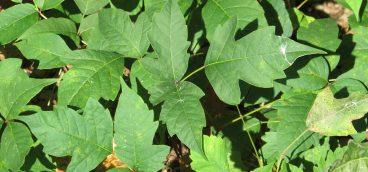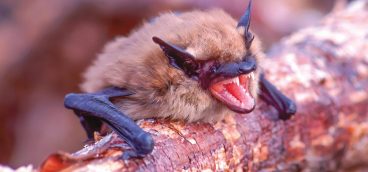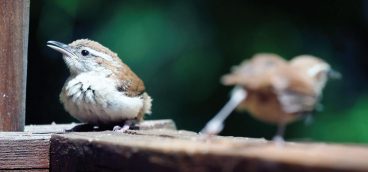Carpenter Bees

We raised our babies in this old farmhouse, wrapped them in swaddling clothes like little cocoons, and protected them as best as we could. We renovated parts of the house, added a bathroom and knocked through a kitchen wall to create more space for a growing family. We fed our children, taught them what we knew. We sent them out into the world.
That’s all carpenter bees want to do.
The female uses her powerful mandibles to chew nearly perfectly round half-inch holes into our front porch railings. She bores an inch deep, then turns at right angles along the wood grain to create tunnels with individual chambers where she lays her eggs. Each baby gets its own bedroom. To nourish them as they transform from egg to larva, pupae to adult, she leaves behind “bee bread,” a mixture of pollen and nectar. She plugs the holes with sawdust and wood pulp and departs.
She works so hard that if she has to build her own birthing rooms, she can have four to five babies; if she inherits an existing nest, she can have 12 or more. She chews with such force that her mandibles wear out. She gathers so much food for her young that her wings get tattered and she no longer can fly. Sometimes she has help from a subordinate queen who’s waiting for her to die to take over the real estate. She lives only one season.
If I look up carpenter bees, I’m offered a host of exterminators, “professional bee removal teams” that claim the females have painful stings that can cause life-threatening allergic reactions, that carpenter bees are a serious property threat, that males frighten people, and bee feces stain surfaces. Dangerous predators, they say, are sure to follow carpenter bees. The companies promote using insecticide.
But I don’t want to use insecticide. I don’t want to kill the carpenter bees. I just want to protect our porch railing.
I try less harmful remedies. I surround the porch with bee motels and cavity-nesting bees indeed move in — but the carpenter bees stay put. I spray lemon oil into the holes — citrus and almond oils are said to deter them — but that does nothing. Websites suggest offering them brush piles and snags as alternatives; well, we certainly have no shortage of those on the farm, but the carpenter bees apparently prefer our porch. They’re supposed to dislike painted surfaces and our porch is painted white — but if I contort myself and turn upside down to look underneath the railing, I see unpainted access holes, impossible to paint without removing the railing. Wind chimes are said to discourage them, but I’d rather listen to the sound of the buzzing bees. I do not try fake wasp nests.
What’s a homeowner to do? I ask a bee expert.
“There is a narrative that these bees are destructive and dangerous and it simply isn’t true in most cases,” said Kate Anton, lab manager for the Grozinger Lab at Penn State’s Center for Pollinator Research. Severe infestations can jeopardize buildings, she said, but that generally happens to untreated surfaces and when woodpeckers decide to eat the carpenter bees. “A few carpenter bees are not going to threaten a structure,” she said.
She believes I’ll never lure them elsewhere. “I don’t know anything that is successful in persuading them away,” she said.
The Eastern Carpenter Bee (Xylocopa virginica; Xylocopa means wood cutter) is native to Pennsylvania and important to our ecosystem for many reasons. They provide food for birds, decompose fallen trees and put nutrients back into the soil. “Eighty percent of flowering plants depend on bees for pollination,” Anton said, and carpenter bees are good pollinators. They use what’s called “buzz pollination,” which is when a bee grasps a flower with its jaw, vibrates its wings, and releases huge amounts of pollen — particularly good for pollinating blueberries, tomatoes, eggplant, and peppers. They and bumble bee queens are our largest native bees, so they can fly when smaller bees are grounded, and they pollinate later into autumn than other bees. (It’s easy to confuse carpenter bees with bumble bees. Bumble bees have fuzzy abdomens that are black and gold, whereas the carpenter bee abdomen is shiny and all black.)
For 10 summers, maybe longer, I’ve observed the female carpenter bee climb in and out of her borings. I’ve seen undeveloped babies fall out of the porch railing, perhaps awakened too soon from hibernation. I’ve seen four-toothed mason wasps take over carpenter bee nests and deliver caterpillars to their own young. I’ve watched piles of sawdust, called “frass,” accumulate on the porch floor, and I’ve been dive-bombed by the male carpenter bee as I walk in and out of the front door. His buzz is loud and he gets so close to my face that I can see the white square on his. But he amuses me because I know he’s only doing what a carpenter bee father does — defending his territory and protecting his babies — and he doesn’t know what I know: that he cannot sting. (Females do, but rarely, because they have too much work to do.)
Our human structures are one reason the carpenter bee population is stable. We give them more places to nest. By contrast, our bumble bees, which generally nest underground, are in trouble. Of Pennsylvania’s 18 bumblebee species, five are of conservation concern and one, the rusty-patched bumble bee, is endangered, having lost 90 percent of its range. Carpenter bees are also able to forage on a wide diversity of plants, Anton said. “While some species of bees require very precise plants and environments, the sturdy carpenter bee can make do in our changing climate.”
For people who want to eliminate carpenter bees, some websites suggest sealing holes with steel wool or copper gauze, dowel rods and wood putty, but Anton says they’ll chew their way out. “You can entomb them but they will chew themselves a new exit,” she said. Other websites suggest inserting wire deep into the holes and skewering them. But Anton said the only way to get rid of them is to dust the nest with pyrethrum, which she suggests only if the structure is at serious risk.
“This pesticide is toxic to cats and insects and certainly it is not something that anyone would want on their skin,” she said. Use a professional, she advised. “I would urge everyone to first evaluate the risk of the bees and compare that to the risk of pesticide exposure.”
Anton thinks if I’ve had carpenter bees for 10 years and my porch is still intact, I may not have cause for worry. We don’t know for sure, of course, but nevertheless, I’m going to leave my bees alone. Others may think differently, may be driven crazy with annoyance or worry, but I think it’s at least worth considering how these amazing bees contribute to our very existence. If we understand better the lives of the creatures that surround us — we might think twice before instinctively grabbing the insecticide. For me, it’s a wonder, too, to be this close to nature; besides, after having given birth to two children, I’ve aligned myself with that mama carpenter bee — her worn-out mandibles and her tattered wings.












